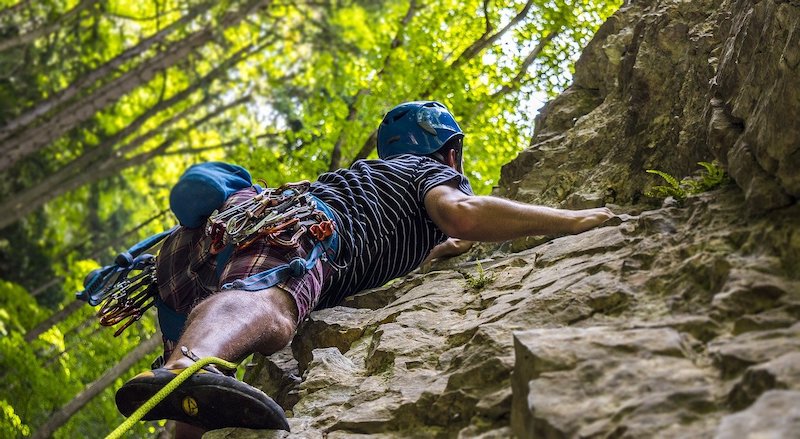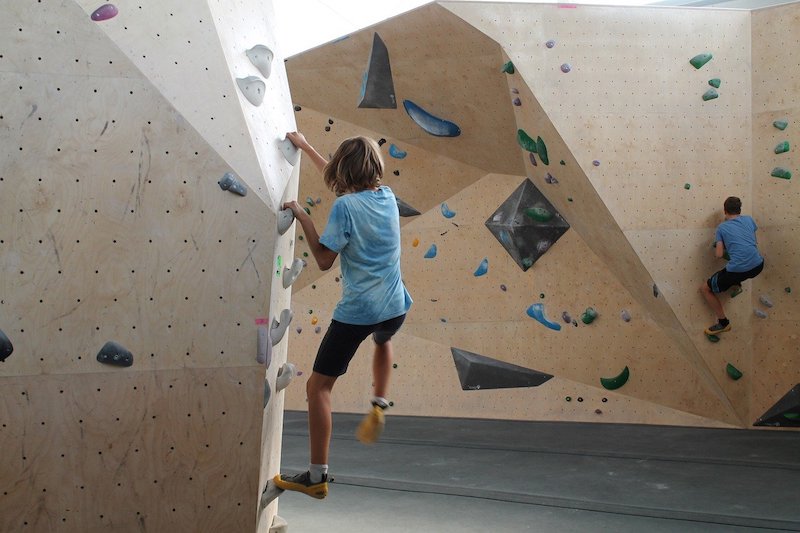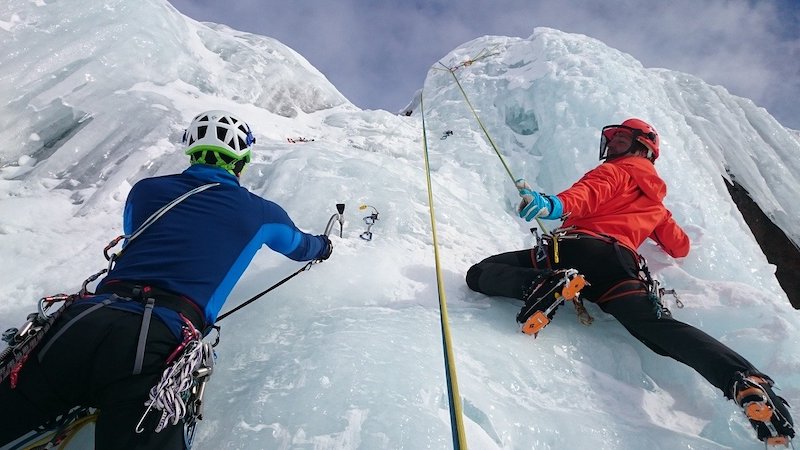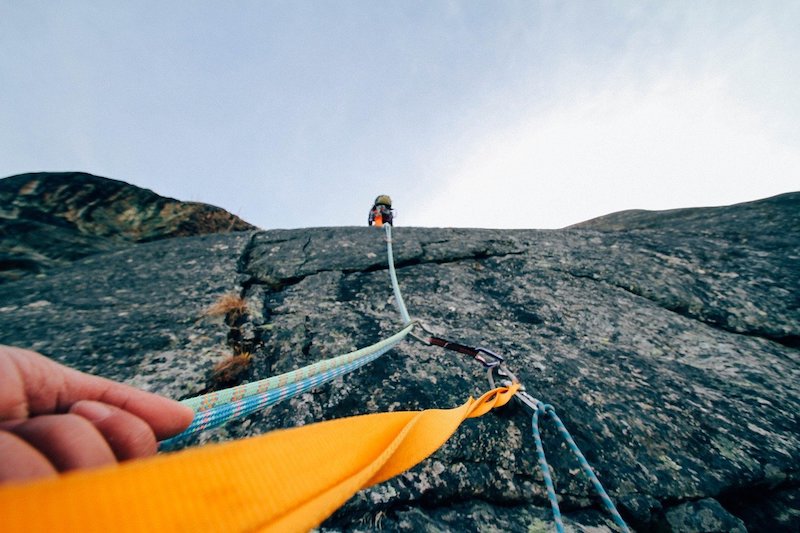If you want to be a better rock or boulder climber, there are some important techniques that will help to enhance your physical fitness. But, first, let’s take a look at the sport, before finding out how to improve as a climber.

Rock climbing and bouldering
Rock climbing and bouldering are popular sports and for many good reasons. They can be enjoyed indoors and outdoors by a wide range of age groups and they offer plenty of great challenges.
As well as providing good physical fitness benefits, such as stronger muscles and better flexibility, there are mental health benefits, too. Being focused on a climbing route or bouldering problem allows you to switch off from your everyday stresses and enjoy being in the moment.
For some people, it’s enough to train while climbing but if you want to improve in your sport you do need to focus on some specific training. Strength building is vital, from fingers, to arms, legs and core.
Cardiovascular fitness is important as well. Climbing might look like a relaxed sport but it takes great stamina, endurance and cardio fitness to be able to climb tough routes.
There is also the balance of weight to strength to think about. It is a fact that if you are lighter weight and strong it is easier to climb.
Other challenges of rock climbing include having a good head for heights and being able to stay safe. It is a good idea to take a few lessons or to learn from a more experienced climbing friend in the early stages of the sport.


Different types of rock climbing
Climbing can be enjoyed at indoor walls and centres, as well as outdoors. Each type of climbing requires a general and a specific set of climbing gear.
Indoor rock climbing
At climbing walls and bouldering centres, small artificial rocks are bolted on to an indoor wall. Climbing walls tend to be much higher than bouldering walls.
To climb a wall you utilise harnesses and ropes, while at a bouldering centre you do not use ropes but “free climb”. The boulder walls are not as high and if you come off the wall there are thick mats to break your fall.
Some indoor climbing walls have automated self-belay devices so that you can enjoy climbing without a partner. However, for training purposes and for the sociable side of climbing, most people like to climb with a friend.
Outdoor rock climbing
There is a wide variety of different climbing styles and locations, especially across the UK. From limestone crags to ice climbing and through scrambling to severe grades, there is a huge wealth of options.
Some outdoor locations have what is called sport climbing, which is similar to indoor climbing but outdoors. This allows climbers to more safely secure ropes for climbing.
In most other outdoor environments, climbers must rely on their own tools and gadgets, such as cams, to keep them safe. Ropes and belays are still used but they are secured to the rock face with special devices, such as cams. Different sized cams are inserted into holes, cracks and crevices where they expand to stay secure. A system of ropes and carabiners are used by climbers so that if they fall off the rock face their fall is broken and they do not end up landing on the ground.
Ice climbing calls for another set of tools, including screws that are screwed into the ice, crampons for boots and ice axes.


Different exercises for rock climbing and bouldering
There are a number of the general and specific training exercises you can practise to prepare yourself for the many wonderful rock climbing destinations.. here are a few ideas:
Before you start
Make sure that the exercise you pick is right for your body. Do not try to overwork your muscles as you will be exposed to injury.
Progressive overload is the key. Gradually increase the repetitions of your exercises and give yourself a day’s gap in between to allow your muscles to rest. If you do not feel comfortable while performing an exercise, make sure to adjust it according to your fitness level.
Rock climbing itself is extremely beneficial and gives you sufficient physical exercise.


Begin with warm-up
A good portion of your routine should be spent on warm-up and cool down. It is essential to fuel your muscles just like the car engine before you get the car moving. Do a good 10 to 15 minutes of warm-up involving cardio workouts like jogging and jumping jacks.
If you are doing it at home, you can follow YouTube videos of professionals who will guide you through the process. Work on your breathing pattern during this session and as you begin, don’t forget to give yourself short breaks of 60 to 90 seconds between each exercise. You can reduce this time as your fitness level increases.
Work on arms and legs
Many workouts will help you enhance balance and strengthen your arms and legs, as well as fingers. Some of the most common exercises for rock climbing are:
Hang board or finger board training: This exercise impersonates the stress on fingers and your body that is produced during climbing. To perform this exercise, you need to attach your hang board or finger board to the wall.
There are a range of exercises you can do, such as simply hanging from a board or doing pull ups on your fingers.
To ease the load, place a stool or chair below so you can take the weight off your upper body. The further you move the stool away, or eventually remove it, the greater the weight on your arms and fingers.
There are plenty of exercise routines you can find on-line and on Youtube for building strength for climbing.
Jump squat (working on legs): These will train your calf and thigh muscles for climbing, allowing you to generate more power while climbing.
Along with this, you can do the leap squat, which will improve your balance and work on your glutes and quads. You can watch videos of trained professionals online to learn how to do these perfectly. If you are a beginner, don’t forget to adjust it according to your body capacity.
Upper body and core: To build your upper body strength you can do exercises such as dumbbell press and triceps pulls. These will reinforce your arms with the right movements for climbing and are home-friendly exercise. Other suggested upper body exercises are push-ups and pull-ups.
For your core, the most beneficial exercises are crunches, bicycle kicks, planks and situps.
Rock climbing and bouldering are sports that are well worth a try, however if you do decide to indulge, make sure you have the proper fitness training. Remember, practice makes perfect!


